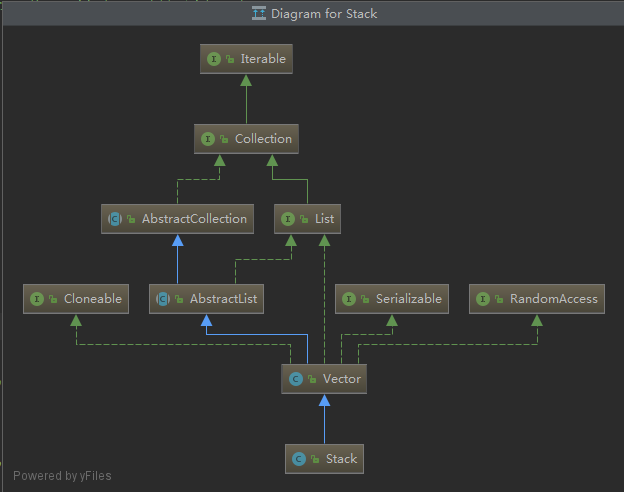jdk1.8-stack 栈源码分析

public
class Stack<E> extends Vector<E>
分析:栈的继承关系很简单,就是继承了Vector,那么我们可以猜测栈操作大部分应该是线程安全的。
/**
* Creates an empty Stack.
*/
public Stack() {
}
/**
* Pushes an item onto the top of this stack. This has exactly
* the same effect as:
* <blockquote><pre>
* addElement(item)</pre></blockquote>
*
* @param item the item to be pushed onto this stack.
* @return the <code>item</code> argument.
* @see java.util.Vector#addElement
*/
public E push(E item) {
//调用父类vector的addElement()方法
addElement(item);
return item;
}
分析:往栈里压入一个元素用push方法,每次往栈的顶部压入元素。addElement()是抽象父类vector方法,我们在vector里已经分析过。从这里我们可以知道,栈的底层数组结构也是数组。
/**
* Removes the object at the top of this stack and returns that
* object as the value of this function.
*
* @return The object at the top of this stack (the last item
* of the <tt>Vector</tt> object).
* @throws EmptyStackException if this stack is empty.
*/
public synchronized E pop() {
E obj;
//栈的长度
int len = size();
//栈顶部的元素值(也就是数组最后一个元素值)
obj = peek();
//栈元素减1
removeElementAt(len - 1);
//返回顶部元素
return obj;
}
分析:删除栈顶部的对象,并将该对象作为函数值返回
/**
* Deletes the component at the specified index. Each component in
* this vector with an index greater or equal to the specified
* {@code index} is shifted downward to have an index one
* smaller than the value it had previously. The size of this vector
* is decreased by {@code 1}.
*
* <p>The index must be a value greater than or equal to {@code 0}
* and less than the current size of the vector.
*
* <p>This method is identical in functionality to the {@link #remove(int)}
* method (which is part of the {@link List} interface). Note that the
* {@code remove} method returns the old value that was stored at the
* specified position.
*
* @param index the index of the object to remove
* @throws ArrayIndexOutOfBoundsException if the index is out of range
* ({@code index < 0 || index >= size()})
*/
public synchronized void removeElementAt(int index) {
//修改次数加1
modCount++;
//校验是否越界
if (index >= elementCount) {
throw new ArrayIndexOutOfBoundsException(index + " >= " +
elementCount);
}
else if (index < 0) {
throw new ArrayIndexOutOfBoundsException(index);
}
//数组需要移动的个数
int j = elementCount - index - 1;
if (j > 0) {
//从index + 1位置开始,向左移动一个位置,移动的个数为j
System.arraycopy(elementData, index + 1, elementData, index, j);
}
//数组实际元素减1
elementCount--;
//数组最后一个元素置为null,等待gc回收
elementData[elementCount] = null; /* to let gc do its work */
}
分析:传进来len -1,栈顶部元素下标,即数组最后一个元素位置。
/**
* Looks at the object at the top of this stack without removing it
* from the stack.
*
* @return the object at the top of this stack (the last item
* of the <tt>Vector</tt> object).
* @throws EmptyStackException if this stack is empty.
*/
public synchronized E peek() {
int len = size();
if (len == 0)
throw new EmptyStackException();
//根据索引从数组里取值,elementAt是调用父类Vector的方法
return elementAt(len - 1);
}
分析:栈的peek()方法,其实就是返回栈顶部的元素值,即数组末尾元素值。
/**
* Returns the component at the specified index.
*
* <p>This method is identical in functionality to the {@link #get(int)}
* method (which is part of the {@link List} interface).
*
* @param index an index into this vector
* @return the component at the specified index
* @throws ArrayIndexOutOfBoundsException if the index is out of range
* ({@code index < 0 || index >= size()})
*/
public synchronized E elementAt(int index) {
if (index >= elementCount) {
throw new ArrayIndexOutOfBoundsException(index + " >= " + elementCount);
}
return elementData(index);
}
分析:这个方法就是根据下标,返回数组的值而已,没啥好分析的。

jdk1.8-stack 栈源码分析的更多相关文章
- Stack的源码分析和应用实例
1.Stack介绍 Stack是栈.它的特性是:先进后出(FILO:First In Last Out). java工具包中的Stack是继承于Vector(矢量队列)的,由于Vector是通过数组实 ...
- Java集合基于JDK1.8的LinkedList源码分析
上篇我们分析了ArrayList的底层实现,知道了ArrayList底层是基于数组实现的,因此具有查找修改快而插入删除慢的特点.本篇介绍的LinkedList是List接口的另一种实现,它的底层是基于 ...
- Java -- 基于JDK1.8的LinkedList源码分析
1,上周末我们一起分析了ArrayList的源码并进行了一些总结,因为最近在看Collection这一块的东西,下面的图也是大致的总结了Collection里面重要的接口和类,如果没有意外的话后面基本 ...
- JDK1.7之 HashMap 源码分析
转载请注明出处:http://blog.csdn.net/crazy1235/article/details/75451812 类继承关系 构造函数 Entry put put putForNullK ...
- Java -- 基于JDK1.8的ThreadLocal源码分析
1,最近在做一个需求的时候需要对外部暴露一个值得应用 ,一般来说直接写个单例,将这个成员变量的值暴露出去就ok了,但是当时突然灵机一动(现在回想是个多余的想法),想到handle源码里面有使用过Th ...
- Java集合基于JDK1.8的ArrayList源码分析
本篇分析ArrayList的源码,在分析之前先跟大家谈一谈数组.数组可能是我们最早接触到的数据结构之一,它是在内存中划分出一块连续的地址空间用来进行元素的存储,由于它直接操作内存,所以数组的性能要比集 ...
- 基于jdk1.8的ArrayList源码分析
前言ArrayList作为一个常用的集合类,这次我们简单的根据源码来看看AarryList是如何使用的. ArrayList拥有的成员变量 public class ArrayList<E> ...
- Java -- 基于JDK1.8的ArrayList源码分析
1,前言 很久没有写博客了,很想念大家,18年都快过完了,才开始写第一篇,争取后面每周写点,权当是记录,因为最近在看JDK的Collection,而且ArrayList源码这一块也经常被面试官问道,所 ...
- Stack&Vector源码分析 jdk1.6
参照:http://www.cnblogs.com/tstd/p/5104099.html Stack(Fitst In Last Out) 1.定义 public class Stack<E& ...
随机推荐
- Spring下的@Order和@Primary与javax.annotation-api下@Priority【Spring4.1后】等方法控制多实现的依赖注入(转)
@Order 可以作用在类.方法.属性. 影响加载顺序. 若不加,spring的加载顺序是随机的. @Primary 当注入bean冲突时,以@Primary定义的为准. @Order是控制配置类的加 ...
- 题解 比赛 match
比赛 match Description 有 N 支队伍打比赛.已知有如下条件: • 每支队伍恰好打了 4 场比赛 • 对于一场比赛,如果是平局,双方各得 1 分:否则胜者得 3 分,负者不得分 给定 ...
- Codeforces Round #449 [ C/A. Nephren gives a riddle ] [ D/B. Ithea Plays With Chtholly ]
PROBLEM C/A. Nephren gives a riddle 题 http://codeforces.com/contest/896/problem/A codeforces 896a 89 ...
- 部署LVS-DR集群
设置Proxy代理服务器的VIP和DIP [root@proxy ~]# cd /etc/sysconfig/network-scripts [root@proxy network-scripts]# ...
- 【Python之路】特别篇--Python装饰器
前情提要 1. 作用域 在python中,函数会创建一个新的作用域.python开发者可能会说函数有自己的命名空间,差不多一个意思.这意味着在函数内部碰到一个变量的时候函数会优先在自己的命名空间里面去 ...
- 【Python之路】特别篇--Django生产环境部署
Django的部署可以有很多方式,采用nginx+uwsgi的方式是其中比较常见的一种方式. uWSGI uWSGI是一个Web服务器,它实现了WSGI协议.uwsgi.http等协议.Nginx中H ...
- 如何制作纯净的U盘启动盘
1.去下载**WinPE工具箱**U盘启动盘制作工具 下载地址:http://www.wepe.com.cn/download.html
- c++两数组合并算法
#include <iostream> #define MAXSIZE 100 using namespace std; int combine(int a[],int b[],int c ...
- rabbitmq 的安装配置使用
前言: 对于消息队列中间件: #redis: 功能比较全,但是如果突然停止运行或断电会造成数据丢失 #RabbitMQ:功能比较齐全.稳定.便于安装,在生产环境来说是首选的 1.下载软件[下载较慢,请 ...
- yum update 更新失败
1.yum安装东西的时候,老是报:There are unfinished transactions remaining. You might consider running yum-complet ...
